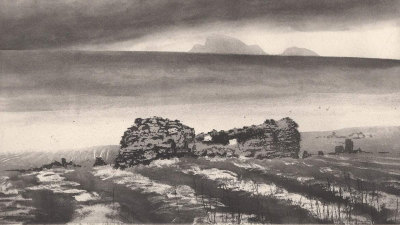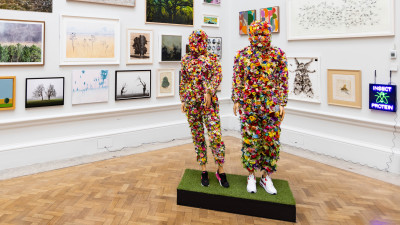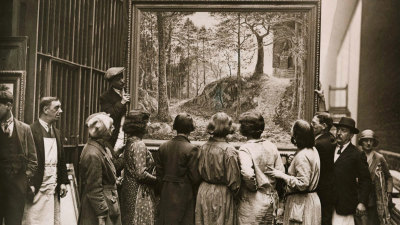Rebecca Salter RA on the tradition of Japanese woodblock printing
By Rebecca Salter RA
Published 26 June 2015
The Academician has spent her career studying and promoting the threatened art of Japanese woodblock printing. Here, she tells us about her new prints, commissioned for the Summer Exhibition.
-
As a newly elected Academician, the work you submit to your first Summer Exhibition has special meaning and significance. I have both studied and lived in Japan and was keen to reflect my transformative experience of the country in my first submission. A specially commissioned set of Japanese woodblock prints seemed to be the perfect vehicle.
I have a passion for Japanese art and especially for woodblock prints, a printing technique using, traditionally, Japanese paper, cherry wood and water-based inks. I am attracted to the visual sophistication of the prints; the flat colour, the bold, cropped compositions and, above all, the fluidity of the lines.
When I lived in Kyoto I learned the technique of printing from Kurosaki Akira, Professor of Printmaking and Paper Making at Kyoto Seika University, and from him I developed an even greater admiration for the largely unknown craftsmen who originally produced these masterpieces. The Japanese woodblock prints with which we are all familiar were products of the affluent merchant class of Edo (now Tokyo) from the 17th to the 19th centuries. These Ukiyo-e prints, “pictures of the floating world,” illustrate a culture of kabuki (Japanese theatre), sumo wrestlers and courtesans. Their production was efficient: a publisher would oversee the choice of artist and the carvers and printers who operated from their own workshops. Subtle differences developed between the Tokyo and Kyoto styles of printing. The western audience is more familiar with the Tokyo style through the work of such famous names as Hokusai and Hiroshige. The Kyoto style of woodblock prints developed through close links with the famous Kyoto textile industry so tends towards a softer, more painterly style.
However, with the introduction of offset lithography (the printing press) in the late 19th-century, the medium endured a slow decline. After a brief revival following the Second World War, in which the number of craftsmen temporarily increased, there are now only five professional carvers and perhaps 60 professional printers left in Japan.
-
I have a passion for Japanese art... its visual sophistication, the flat colour, the bold, cropped compositions and, above all, the fluidity of the lines
Rebecca Salter RA
-
I have spoken to many of the craftsmen still working and am not pessimistic about the current health of the medium. But while I have huge respect for their skill, talent and ingenuity, it would be folly to ignore some of the challenges they face. For the technique to thrive, the craftsman need the tools and materials they work with to survive. Perhaps the most crucial material is Japanese paper, washi, as, unlike western-style woodcut prints (using oil-based inks), the Japanese style is water-based, working only with washi. Whereas Japanese woodblocks were traditionally carved in cherry wood, now most carvers work in plywood. The colours used to be composed of natural pigments (beautiful but very fragile); now, most printers use gouache. These technical changes have been absorbed and adapted out of necessity. But there is one greater challenge: the craftsmen need a healthy market for their work. To thrive they need commissions for their work and in a small way I hope to make the Summer Exhibition part of that story.
I have previously commissioned the Sato Woodblock Workshop in Kyoto to produce an edition of prints and I had no hesitation in approaching them again. Much of Sato’s most celebrated work is the reproduction of famous paintings, such as Takeuchi Seiho’s wonderful Tabby Cat (1924). Sato’s reproduction uses approximately 150 woodblocks, perfectly capturing the soft brushstrokes of the original. It is hard to believe that it has been carved in wood.
-

Utagawa Hiroshige, Utagawa Toyokuni, Twin brush, Gojusantsugi Mariko, Edo period.
Woodblock print. © Tokyo National Museum.
-
Sato’s father left rural Japan in his early teens to serve his printmaking apprenticeship in Tokyo. It takes a long time for a printer to learn his craft: apprenticeships last between 10 and 15 years and require extraordinary dedication. Afterwards, he started his own workshop in a small traditional-style house on a quiet street in central Kyoto. Four people now work with him, including a senior printer, Nakayama Makoto, and (unusually) a young female apprentice, Hirai Kyoko. They work upstairs in a single room, sitting cross-legged on the floor and printing on a low bench.
For me, the most interesting and enjoyable part of the process was sitting with Sato, Nakayama and Kitamura and looking at a selection of drawings and watercolours, working out how exactly to make them work in wood. When I went to meet them in March this year, they joked that producing an exquisite painterly print with 150 blocks is relatively easy, but they would enjoy the challenge of my prints because my modest budget means we can only use a few blocks per print.
Every year I plan to use my commission for the Summer Exhibition to employ and promote the extraordinary technical virtuosity of the Sato workshop. I hope that new audiences will learn about the complexities of Japanese woodblock printing and become aware of its story of survival in the 21st century. The craft has a glorious past and it deserves an equally glorious future, in which I hope the Royal Academy will be part.
-
I hope that new audiences will learn about the complexities of Japanese woodblock printing and become aware of its story of survival in the 21st century.
Rebecca Salter RA
-
Gallery

Sato Keizou outside his Kyoto workshop

Reproduction of Takeuchi Seiho’s 'Tabby Cat' (1924) (detail)

Pots of colour are lined up ready for printing

Nakayama Makoto, the senior printer in the Kyoto workshop

A variety of brushes are used to spread colour onto the woodblocks

Hirai Kyoko in the Kyoto workshop

Hirai Kyoko at work

Rebecca Salter RA, Celestial 1 and 2, 2015.
-
Rebecca Salter RA’s prints from the Sato Woodblock Workshop in Kyoto are part of the Summer Exhibition.












